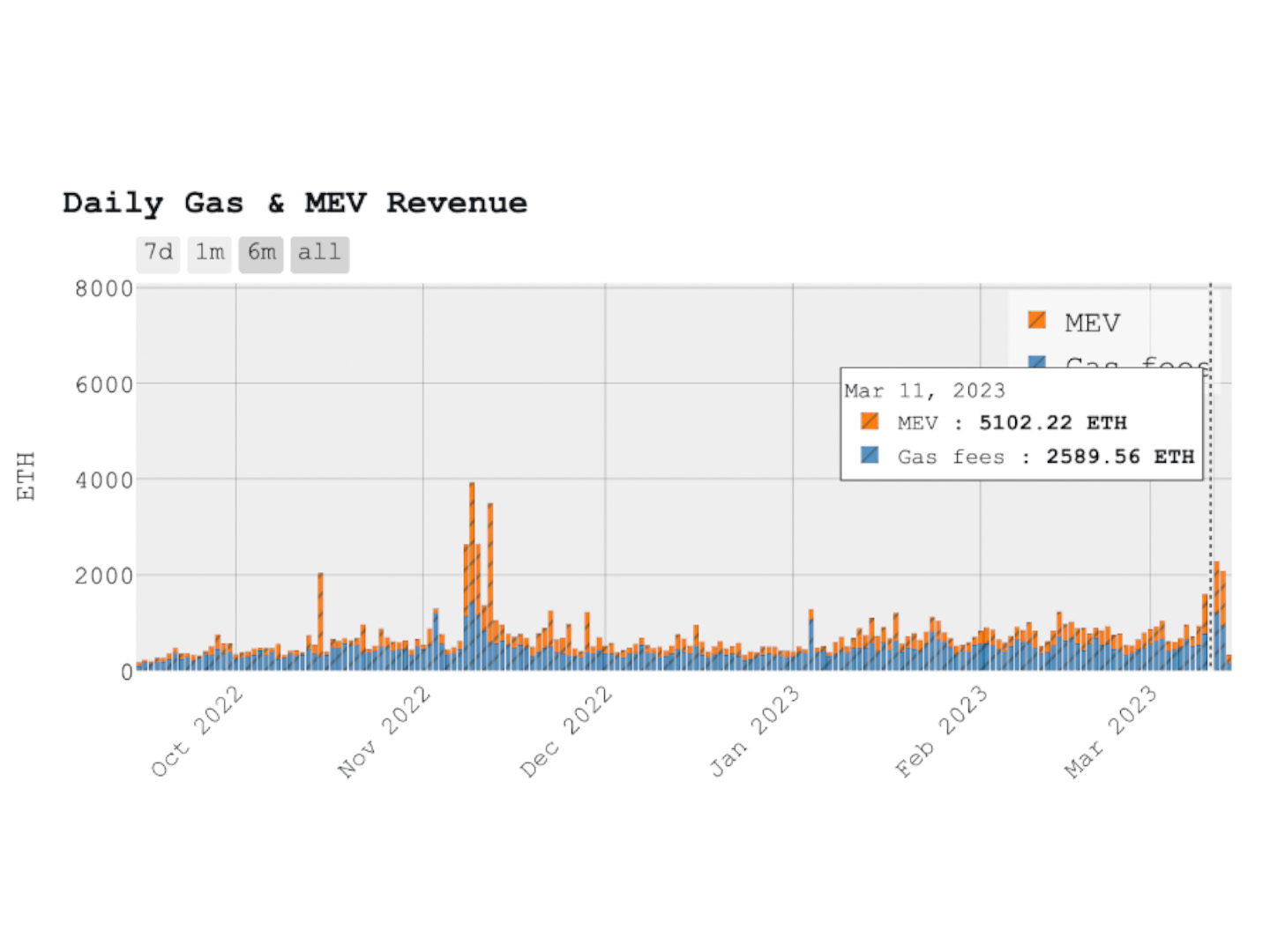MEV Rewards on Ethereum Reach All-Time High During SVB Bank Run and USDC Depeg
Profits made from MEV were more than twice as high as the last peak during the FTX implosion.
Last Friday’s Silicon Valley Bank (SVB) collapse and subsequent contagion around what that means for the crypto industry drove a dramatic increase in the profitability for validators who run the Ethereum network.
As the tech industry blew up over the weekend, Ethereum validators saw profits from MEV (maximal extractable value) spike as the bank collapsed and as stablecoin USDC depegged from $1, according to data about Flashbots, which supplies the software responsible for 89% of all MEV activity.
MEV is a central component as part of trading on the Ethereum protocol. MEV refers to the additional profits that validators earn as a result of inserting or reordering transactions within a block. Some have compared MEV similar to arbitrage in traditional markets.
This article originally appeared in Valid Points, CoinDesk’s weekly newsletter breaking down Ethereum’s evolution and its impact on crypto markets. Subscribe to get it in your inbox every Wednesday.
The main way that Ethereum validators can get MEV is through MEV-Boost, a software developed by Flashbots that allows validators to request blocks from a network of builders. Validators get these blocks from MEV-Boost through relays to earn MEV. Because 89% of validators use MEV-Boost to add blocks to the blockchain, and Flashbots has relayed most of those blocks, most of the data reflecting MEV activity is reflected in their numbers.
After regulators shut down SVB, stablecoin issuer Circle confirmed late on Friday that $3.3 billion in cash deposits remained at the bank, or about 8% of the total reserves backing its stablecoin USDC, causing the stablecoin to depeg from its 1:1 ratio with the U.S, dollar. Consequently, users rushed to cash out their USDC or move their crypto.
As the news of one of the largest stablecoin issuers in the crypto industry riled the markets, the movement of people’s crypto meant that there were more transactions available to generate MEV profits.

(Mevboost.pics dashboard)
During this time, users of Flashbots’ MEV-Boost relay raked in a peak of 7,691 ETH in rewards worth about $13 million on March 11. This was more than twice as high as the last peak, which occurred during the FTX blowup on Nov. 9 when MEV rewards earned with Flashbots were 3,202 ETH or $5.5 million.
By March 12, MEV profits significantly decreased to regular levels, with MEV rewards via Flashbots bringing in 2,282 ETH. The calming in the movement of transactions probably came after the announcement that Circle would cover any shortfall in USDC reserves, leading to USDC regaining its peg.
Toni Wahrstätter, an Ethereum researcher who created a Flashbots MEV-monitoring dashboard, told CoinDesk, “In times of extremely high MEV, it's good to know that the MEV rewards mostly end up with the validators, who don't have to run complex algorithms, engage in private deals or anything but just be lucky while securing the Ethereum blockchain.”
Some Ethereum users that ran their own validators noted the gigantic increase in MEV over the weekend, hoping they could have their own share of the MEV rewards.
Whenever there is massive news that affects financial markets, prices of coins move quickly and create opportunities for profit. Ethereum validators are no different when it comes to profiting off the contagion of ordinary bank runs.
DISCLOSURE
Please note that our privacy policy, terms of use, cookies, and do not sell my personal information has been updated.
The leader in news and information on cryptocurrency, digital assets and the future of money, CoinDesk is a media outlet that strives for the highest journalistic standards and abides by a strict set of editorial policies. CoinDesk is an independent operating subsidiary of Digital Currency Group, which invests in cryptocurrencies and blockchain startups. As part of their compensation, certain CoinDesk employees, including editorial employees, may receive exposure to DCG equity in the form of stock appreciation rights, which vest over a multi-year period. CoinDesk journalists are not allowed to purchase stock outright in DCG.
Learn more about Consensus 2023, CoinDesk’s longest-running and most influential event that brings together all sides of crypto, blockchain and Web3. Head to consensus.coindesk.com to register and buy your pass now.
:format(jpg)/www.coindesk.com/resizer/Kjea5zGf89qzyacI8fZ49yhnaks=/arc-photo-coindesk/arc2-prod/public/S7SPGELTNBFITA3UBCS2CMRBQM.png)
:format(jpg)/cloudfront-us-east-1.images.arcpublishing.com/coindesk/HHAZAAXSBJD3NLASNFQDKP3WOE.png)
:format(jpg)/cloudfront-us-east-1.images.arcpublishing.com/coindesk/3XAH3BH7BZE5ZNY2XTZ5BLD7QI.jpg)
:format(jpg)/cloudfront-us-east-1.images.arcpublishing.com/coindesk/MM3UAOZCG5AUZIPOQ65VFTGA4U.jpg)
:format(jpg)/cloudfront-us-east-1.images.arcpublishing.com/coindesk/Z3I2HMMBABCOJMIVKQT34UWXHI.jpg)